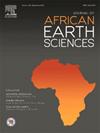Exploratory evaluation of gold mineralization in Sodmein and El Haramiya areas, west Quseir, Egypt
IF 2.2
4区 地球科学
Q2 GEOSCIENCES, MULTIDISCIPLINARY
引用次数: 0
Abstract
The rock units exposed in the West Quseir region, encompassing the Wadi Sodmein (WS) and El Haramiya (EH) areas, are predominantly composed of metamorphic and igneous formations associated with the Pan-African Arabian–Nubian Shield. The Precambrian Nubian Shield, which constitutes the western segment of the Arabian–Nubian Shield, is well known for hosting significant mineral deposits, including iron ore, gold, copper, and rare earth elements. The primary objective of this study is to elucidate the structural framework and mineralization processes within these economically promising zones. It involves comprehensive field-based geological investigations, during which approximately 60 samples were collected for detailed petrographic analysis of the West Quseir region, specifically within the EH and WS subareas of Egypt's Eastern Desert. To achieve this, available aeromagnetic data were analysed using advanced filtering techniques, including Analytic Signal (AS), Source Parameter Imaging (SPI), Tilt Derivative, Euler Deconvolution (ED), Contact Occurrence Density (COD), and magnetic susceptibility anomaly inversion along selected land magnetic profiles. The findings reveal a complex network of dominant NW–SE and NE–SW oriented lineaments, which correspond to major shear zones and fault systems that exert significant control over mineral deposition. The filtered magnetic data delineates several anomalies that are consistent with the occurrence of gold mineralization. Additionally, rock sampling and structural measurements confirm the presence of gold-bearing quartz veins, as previously documented in earlier studies. Detailed petrographic analysis further substantiates the potential for gold mineralization within the study area, reinforcing its significance as a prospective exploration target.

埃及古西尔西部Sodmein和El Haramiya地区金矿化勘探评价
在西Quseir地区,包括Wadi Sodmein (WS)和El Haramiya (EH)地区,暴露的岩石单元主要由与泛非洲阿拉伯-努比亚地盾相关的变质岩和火成岩组成。前寒武纪的努比亚地盾,构成了阿拉伯-努比亚地盾的西部部分,以拥有重要的矿藏而闻名,包括铁矿石、金、铜和稀土元素。本研究的主要目的是阐明这些经济前景区内的构造格局和成矿过程。它涉及全面的实地地质调查,在此期间,收集了大约60个样本,对西Quseir地区进行了详细的岩石学分析,特别是在埃及东部沙漠的EH和WS次区域。为了实现这一目标,可用的航磁数据使用先进的滤波技术进行分析,包括分析信号(AS)、源参数成像(SPI)、倾斜导数、欧拉反褶积(ED)、接触产动密度(COD)和沿选定的陆地磁剖面的磁化率异常反演。研究结果揭示了以NW-SE和NE-SW为主的复杂构造网,这些构造网对应着对矿物沉积起重要控制作用的主要剪切带和断裂系统。过滤后的磁资料圈定了几个与金矿化产状一致的异常。此外,岩石取样和构造测量证实了含金石英脉的存在,这在早期的研究中得到了证实。详细的岩相分析进一步证实了研究区内金矿化的潜力,加强了该区作为远景找矿目标的意义。
本文章由计算机程序翻译,如有差异,请以英文原文为准。
求助全文
约1分钟内获得全文
求助全文
来源期刊

Journal of African Earth Sciences
地学-地球科学综合
CiteScore
4.70
自引率
4.30%
发文量
240
审稿时长
12 months
期刊介绍:
The Journal of African Earth Sciences sees itself as the prime geological journal for all aspects of the Earth Sciences about the African plate. Papers dealing with peripheral areas are welcome if they demonstrate a tight link with Africa.
The Journal publishes high quality, peer-reviewed scientific papers. It is devoted primarily to research papers but short communications relating to new developments of broad interest, reviews and book reviews will also be considered. Papers must have international appeal and should present work of more regional than local significance and dealing with well identified and justified scientific questions. Specialised technical papers, analytical or exploration reports must be avoided. Papers on applied geology should preferably be linked to such core disciplines and must be addressed to a more general geoscientific audience.
 求助内容:
求助内容: 应助结果提醒方式:
应助结果提醒方式:


